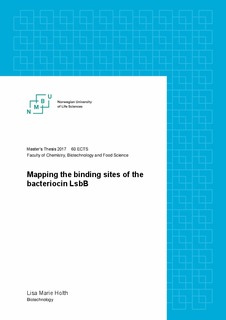| dc.contributor.author | Holth, Lisa Marie | |
| dc.date.accessioned | 2017-08-24T08:39:57Z | |
| dc.date.available | 2017-08-24T08:39:57Z | |
| dc.date.issued | 2017 | |
| dc.identifier.uri | http://hdl.handle.net/11250/2451702 | |
| dc.description.abstract | LsbB is a class II leaderless bacteriocin targeting only lactococcal cells. It uses the Zn-dependent metallopeptidase RseP (YvjB) as a receptor. RseP has a conserved catalytic site, HExxH, at the N-terminal, which is common for the Zn-dependent metallopeptidases. There is evidence indicating that the binding site of LsbB is located at the C-terminal part of RseP. Another bacteriocin EJ97, related to LsbB but produced by enterococcal strains, also targets the same receptor. This bacteriocin has a broader antimicrobial spectrum, including both lactococcal and enterococcal cells. The aim of this study was to identify the bacteriocin binding sites for LsbB, as well as to examine whether the proteolytic site of RseP is important for the receptor function. In addition, it was of interest to identify which part of RseP is responsible for the binding of LsbB to only lactococcal cells, and not enterococcal cells.
To examine whether the proteolytic site is involved in receptor function, point mutations were created, where the conserved residues were changed to alanine. Heterologous expression was performed, and the altered rseP genes were expressed in the heterologous host Streptococcus pneumoniae. The results showed that changes in the active sites, especially when all of the active site residues were changed, made the strains a lot more resistant to LsbB than the strain expressing wild type lactococcal rseP. To evaluate which part of RseP is responsible for lactococcal cells’ specific sensitivity to LsbB, hybrids were created, where parts of the lactococcal RseP were replaced with the corresponding part from the enterococcal protein. Both enterococcal and lactococcal RseP consists of four transmembrane helices, and the hybrids were made so that they contained different combinations of the lactococcal and the enterococcal helices. The sensitivity to LsbB was checked for all of the hybrid RseP, and the results showed that the second and the third helices needed to be lactococcal for the strains to be sensitive to LsbB. The strains where the second and the third helices were not lactococcal became totally resistant. Altogether, it seems like the third transmembrane helix is important for the first binding of LsbB, whilst the second helix, as well as the catalytic site, are important for the formation of the complex that leads to destruction of the cell membrane. The study revealed some interesting results, however the details of the binding and destruction of the cells by LsbB need to be studied further. A thorough understanding of the bacteriocins, their receptors and their mode of action, is important to develop these molecules into useful and safe application. | nb_NO |
| dc.description.abstract | LsbB tilhører klasse II lederløse bakteriosiner, som kun angriper laktokokker. Det bruker den zink-avhengige metallopeptidasen RseP (YvjB) som reseptor. RseP har et konservert katalytisk sete, HExxH, på N-terminalen, som er felles for alle zink-avhengige metallopeptidaser. Det er bevis som indikerer at bindingssetet til LsbB er lokalisert på C-terminal enden til RseP. Et annet bakteriocin EJ97, som er beslektet med LsbB, men produsert av enterokker, bruker også RseP som reseptor for å angripe celler. Dette bakteriosinet har et bredere antimikrobielt spektrum, som inkluderer både laktokokker og enterokokker. Målet med denne oppgaven var å identifisere bindingssetet til LsbB, i tillegg til å evaluere om det konserverte proteolytiske setet til RseP er viktig for funksjonen som reseptor. I tillegg var det av interesse å identifisere hvilken del av RseP som gjør at LsbB kun binder spesifikt til laktokokker og ikke enterokokker.
For å finne ut om det proteolytiske setet er involvert i funksjonen som reseptor, ble det gjort punktmutasjoner, der de konserverte residuene ble endret til alanin. Det ble så gjort heterolog uttrykkelse, der de endrete rseP genene ble uttrykt i den heterologe verten Streptococcus pneumoniae. Resultatene viste at forandringene i det aktive setet, spesielt når alle residuene i det aktive setet ble endret, gjorde at stammene ble mye mer resistente til LsbB enn stammen som uttrykte villtype laktokokk rseP. For å evaluere hvilken del av RseP som er ansvarlig for laktokokkenes spesifikke sensitivitet til LsbB, ble det laget hybrider. I disse hybridene ble deler av laktokokk RseP erstattet med de korresponderende delene av enterokokk RseP. Både enterokokk og laktokokk RseP består av fire transmembranhelixer, og hybridene ble laget så de inneholdt ulike kombinasjoner av laktokokke og enterokokke helixer. Sensitiviteten til LsbB ble sjekket for alle RseP-hybridene, og resultatene viste at den andre og den tredje helixen trengte å være fra Lactococcus lactis for å være sensitive til LsbB. Stammene der den andre og den tredje helixen ikke var fra L. lactis ble totalt resistente. Det ser ut til at den tredje helixen er viktig for den første bindingen av LsbB, mens den andre helixen, i tillegg til det proteolytiske setet, er viktig for formeringen av komplekset som fører til ødeleggelse av cellemembranen. Dette studiet avslørte interessante resultater, men detaljene om binding og ødeleggelse av cellene av LsbB trenger å bli studert videre. En grundig forståelse av bakteriosiner, deres reseptorer og deres virkemåte er viktig for å kunne utvikle disse molekylene for en nyttig og trygg anvendelse. | nb_NO |
| dc.language.iso | eng | nb_NO |
| dc.publisher | Norwegian University of Life Sciences, Ås | nb_NO |
| dc.rights | Attribution-NonCommercial-NoDerivatives 4.0 Internasjonal | * |
| dc.rights.uri | http://creativecommons.org/licenses/by-nc-nd/4.0/deed.no | * |
| dc.title | Mapping the binding sites of the bacteriocin LsbB | nb_NO |
| dc.type | Master thesis | nb_NO |
| dc.description.localcode | M-BIOTEK | nb_NO |

